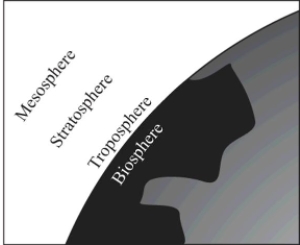A) UV-A
B) UV-B
C) UV-C
D) They are all absorbed approximately equally
Correct Answer

verified
Correct Answer
verified
Multiple Choice
Single bonds,double bonds,and triple bonds
A) have 1,2,and 3 shared electrons,respectively.
B) have 2,4,and 6 shared electrons,respectively.
C) have 3,6,and 9 shared electrons,respectively.
D) are only possible between carbon atoms.
Correct Answer

verified
Correct Answer
verified
Multiple Choice
The "ozone layer" is found
A) only around the equator.
B) in the troposphere.
C) in the stratosphere.
D) in the mesosphere.
Correct Answer

verified
Correct Answer
verified
Multiple Choice
Increasing wavelength of light goes in this order.
A) Ultraviolet > visible > infrared
B) Visible > infrared > ultraviolet
C) Infrared > visible > ultraviolet
D) Ultraviolet > infrared > visible
Correct Answer

verified
Correct Answer
verified
Multiple Choice
In Earth's atmosphere,where is the ozone layer? 
A) Troposphere
B) Biosphere
C) Mesosphere
D) Stratosphere
Correct Answer

verified
D
Correct Answer
verified
Multiple Choice
Which is one of the Lewis structures for ozone?
A) ![]()
B) ![]()
C) ![]()
D) ![]()
Correct Answer

verified
Correct Answer
verified
Multiple Choice
UV-B radiation has a frequency of approximately 1017 s¯1.What is the energy of a photon of this light?
A) 1.99 × 10¯42 J
B) 6.63 × 10¯17 J
C) 4.19 × 108 J
D) 1.51 × 1050 J
Correct Answer

verified
Correct Answer
verified
Multiple Choice
Which of the following is most biologically damaging type of radiation?
A) UV-A
B) UV-B
C) UV-C
D) Infrared
Correct Answer

verified
Correct Answer
verified
Multiple Choice
How do mineral nanoparticles in sunscreens protect from UV radiation?
A) The particles scatter incoming UV light
B) The particles absorb incoming UV light
C) The particles dissolve with incoming UV light
D) None of these choices are correct
Correct Answer

verified
Correct Answer
verified
Multiple Choice
What is the role of polar stratospheric clouds (PSCs) on the destruction of ozone?
A) The cold clouds react with ozone to make oxygen molecules and oxygen atoms
B) Chemical reactions occur on the clouds that convert molecules that do no damage to those that deplete ozone
C) They play no role
D) The clouds are made of chlorine atoms from CFCs
Correct Answer

verified
Correct Answer
verified
Multiple Choice
Decreased stratospheric ozone concentrations may lead to
A) increased incidences of melanomas.
B) harm to young marine life.
C) an increased occurrence of cataracts.
D) All of these choices are correct
Correct Answer

verified
D
Correct Answer
verified
Multiple Choice
The Montreal protocol is a
A) treaty to protect against global warming.
B) treaty to reduce the amount of CFCs produced in the world.
C) list of substitutes for CFCs.
D) way to destroy CFCs in the stratosphere.
Correct Answer

verified
B
Correct Answer
verified
Multiple Choice
The two chemical bonds and geometry of water are best represented by
A) ![]()
B) ![]()
C) ![]()
D) ![]()
Correct Answer

verified
Correct Answer
verified
Multiple Choice
The speed of light in air
A) depends only on the frequency of the light.
B) depends only on the wavelength of light.
C) is independent of the wavelength and frequency of light.
D) depends on both the wavelength and the frequency of light.
Correct Answer

verified
Correct Answer
verified
Multiple Choice
Which statement is correct?
A) UV-A is the most energetic of the three forms of UV light
B) UV-B is the most energetic of the three forms of UV light
C) UV-C is the most energetic of the three forms of UV light
D) UV-A,UV-B,and UV-C are equally energetic
Correct Answer

verified
Correct Answer
verified
Multiple Choice
Why are HFCs environmentally superior to the currently used HCFCs?
A) HFCs are not flammable
B) HFCs do not contain chlorine
C) HFCs are lighter and may be transported more easily
D) HFCs are less reactive than HCFCs
Correct Answer

verified
Correct Answer
verified
Multiple Choice
In reference to waves,frequency is the
A) number of waves passing a fixed point in one second.
B) height of the wave.
C) distance between successive peaks in a wave.
D) distance between a peak in a wave to the next trough.
Correct Answer

verified
Correct Answer
verified
Multiple Choice
Which is the correct Lewis structure?
A) ![]()
B) ![]()
C) ![]()
D) ![]()
Correct Answer

verified
Correct Answer
verified
Multiple Choice
Chlorofluorocarbons rise to the stratosphere and
A) react directly with stratospheric ozone to destroy it.
B) interact with UV energy to produce free radicals that destroy ozone.
C) interact with UV energy to produce free radicals that react with oxygen to create ozone.
D) react with free radicals to remove carbon dioxide.
Correct Answer

verified
Correct Answer
verified
Multiple Choice
Which contributes to the ozone hole?
A) Automobile exhaust
B) Chlorofluorocarbons (CFCs)
C) Loss of northern forests
D) All of these choices are correct
Correct Answer

verified
Correct Answer
verified
Showing 1 - 20 of 50
Related Exams